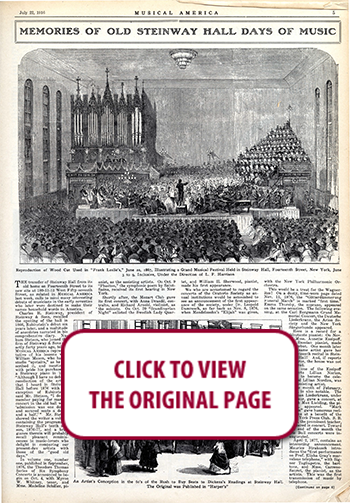 100 YEARS AGO IN MUSICAL AMERICA (155)
100 YEARS AGO IN MUSICAL AMERICA (155)
July 22, 1916
Page 5
MEMORIES OF OLD STEINWAY HALL DAYS OF MUSIC
THE transfer of Steinway Hall from its old home on Fourteenth Street to its new site at 109-11-13 West Fifty-seventh Street, as related in MUSICAL AMERICA last week, calls to mind many interesting debuts of musicians in the early seventies who later were destined to make their names household words in America.
Charles H. Steinway, president of Steinway & Sons, recalled the opening of the hall in 1866, Rubinstein’s debut six years later, and a multitude of anecdotes narrated in his comprehensive diary. Nahum Stetson, who joined the firm of Steinway & Sons exactly forty years ago, told a MUSICAL AMERICA representative of his lessons with William Mason, who had a studio “upstairs,” as he described it, and mentioned with pride his purchase of a Steinway piano in 1868. ”Although I have no definite recollection of the artists that I heard in Steinway Hall before 1876 with the exception of Rubinstein,” said Mr. Stetson, “I do remember paying for many a concert in the old hall when ‘admission was one dollar, and secured seats a dollar and a half.’“ Mr. Stetson showed the writer a volume containing the programs of Steinway Hall’s tenth season, 1876-77, and a brief glance therein will probably recall pleasant reminiscences to music-lovers who delight in comparing our present-dav artists with those of the “good old days.”
In volume one, number one, published in September, 1876, the Theodore Thomas Series of Six Symphony Concerts is announced to begin on Oct. 4, with Myron W. Whitney, tenor, and Mme. Madeline. Schiller, pianist, as the assisting artists. On Oct. 9 “Phaeton,” the symphonic poem by Saint-Saëns, received its first hearing in New York.
Shortly after, the Mozart Club gave its first concert, with Anna Drasdil, contralto, and Richard Arnold, violinist, as the soloists. On Oct. 20 “Scandinavian Night” enlisted the Swedish Lady Quartet, and William H. Sherwood, pianist, made his first appearance.
We who are accustomed to regard the concerts of the Oratorio Society as annual institutions would be astonished to see an announcement of the first appearance of the society, under Dr. Leopold Damrosch, as far back as Nov. 8, 1876, when Mendelssohn’s “Elijah” was given, with the New York Philharmonic Orchestra.
This would be a treat for the Wagnerites! On a dusty, time-worn page dated Nov. 11, 1876, the “Götterdämmerung Funeral March” is marked “first time.” Emma Thursby, the soprano, appeared on the same occasion. The following evening, at the Carl Bergmann Grand Memorial Concert, the Deutsche Liederkranz, the Arion Society and the New York Sängerbunde appeared.
Here is a record for a debutante pianist: On Nov. 14 Mme. Annette Essipoff, the Russian pianist, made her debut. One month later this same artist gave her seventeenth recital in Steinway Hall! And, if reports are true, the house was not papered.
At one of the Essipoff concerts Lillian Norton, later to become the celebrated Lillian Nordica, was the assisting artist.
The month of February, 1877, is also notable. The German Liederkranz, under A. Paur, gave a concert; at which Max Liebling, the pianist, appeared. “Mark Twain” gave humorous recitations at a benefit of the New York Press Club. S. B. Mills, the prominent teacher, appeared in concert. Toward the end of the month the Ole Bull concerts were inaugurated.
April 2, 1877, contains an interesting announcement. Maurice Strakosch introduces the “first performance on Prof. Elisha Gray’s marvelous telephone,” with Signor Tagliapetra, the baritone, and Mme. Carreno-Sauret, the pianist, as the artists. This was the first transmission of music by telephone.
On May 19, 1877, William Mason, the instructor, played Schumann’s “Variations” for two pianos, with Mme. Essipoff at the other piano. In this year Samuel P. Warren, the noted organist, gave his weekly concerts at the Church of Holy Trinity.
When we speak of the “moderns” today we call to mind Debussy, Strauss, Stravinsky, Schönberg and their ilk; note the program of “moderns” in 1877. We are amazed to find Henselt, Rubinstein, Hans von Bülow, Leschetizky, and Wagner on the list. Surely we need no better sign of the passing of the years!
A few program notes of the day will serve to recall old memories. We read that Jenny Lind donated 40,000 crowns to the Royal Academy, Stockholm, the interest therefrom to be given to needy artists.
Brahms’ B Major Quartet (in manuscript) was performed by the Joachim Quartet, is another item of interest. We read of the appearances of Patti as though she were still in her prime. And so on through scores of “personalities” which bring close to us the figures in the musical world that are referred to by our elders with deference and veneration. The passing of old Steinway Hall is indeed a milestone for those whose memories were wont to hover about it.




 RENT A PHOTO
RENT A PHOTO





